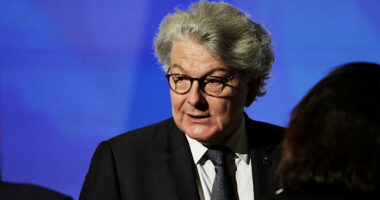Share this @internewscast.com
Wrigley Field marquee reads Ryne “Ryno” Sandberg 1959-2025 in honor of the death of Hall of Fame … More
Copyright 2025 The Associated Press. All rights reserved
It has been a rough few days for ‘80s icons. First, we lost Malcolm-Jamal Warner, who, in the eighties, introduced the world to a middle-class Black teenager during a time his demographic was portrayed very differently in film and on television. Two days later it was Ozzy Osbourne, the hard-core, heavy-metal lead singer of Black Sabbath who found a second chapter on the eponymous reality show “The Osbournes.” Then it was Hulk Hogan, the man who in many ways transformed professional wrestling in the last part of the 20th century.
And yesterday, we lost baseball legend Ryne Sandberg, a player who, in the words of Joe Posnanski, “changed the very meaning of Cubs baseball.” Ryne Sandberg was your favorite baseball purist’s favorite baseball player. Unheralded out of high school, he had planned to play quarterback at Washington State. But Bill Harper, a seasoned scout for the Philadelphia Phillies, took a shine to the player, and convinced the club to both draft Sandberg in the 20th round and to give him a $30,000 signing bonus.
In one of the great heists in baseball history, the Phillies traded Larry Bowa and Sandberg to the Cubs for Iván DeJesús. Bowa didn’t do much for the North Siders, accumulating just 1.5 bWAR over three-plus seasons, but the throw-in changed everything.
Sandberg came in sixth in Rookie of the Year voting in 1982 (another second baseman, Steve Sax, won it as part of a four-year run of Dodgers’ ROYs). His sophomore year he won the first of nine Gold Gloves (all won in succession).
But it was 1984 that put Sandberg and the Cubs on the map. The second baseman led the league in bWAR (8.5), runs (114), and triples (19, to go along with 19 home runs). He slashed .314/.367/.520, became an All-Star for the first time (nine more would follow in succession), won the first of seven Silver Slugger awards, and was named the National League MVP. More importantly, he led the Cubs to the National League East title, and within a game of the NL pennant (he slashed .368/.455/.474 in the NLCS loss to the San Diego Padres).
“Ryno” is probably best remembered for “The Sandberg Game,” which took place on a sunny Saturday in June of 1984. The contest against the Cardinals was the “Game of the Week,” which has special meaning to baseball fans of a certain age. Bob Costas and Tony Kubek were on the call, and they – and America – witnessed Sandberg go 5-for-6 with two home runs, 7 RBI, including two run-scoring singles, a game-tying homer off Bruce Sutter to lead off the bottom of the ninth, and a game-tying two-run dinger with two outs in the bottom of the tenth. The Cubbies ultimately won the game in the bottom of the eleventh on a Dave Owen single, but the day belonged to Sandberg.
Ryne Dee Sandberg played 16 impeccable seasons in the major leagues. He carried himself with confidence, but not arrogance. He was humble to a fault. He ran out every ground ball, and was technically sound on every play at or around second base. He was a leader on the field and in the clubhouse. He hit 282 home runs in his career, 275 while playing second, which ranks third all time (behind only Jeff Kent and Robinson Cano). Sandberg is in the top-10 of essentially every offensive category for second baseman going back over a hundred years.
On the defensive side, his nine Gold Gloves denote a player who is tenth in career fielding percentage at second. But that ranking belies the fact that he played four thousand more innings at the position than anyone else above him.
After “The Sandberg Game,” Cardinals manager Whitey Herzog – a baseball lifer not prone to hyperbole – said “Sandberg is the best player I have ever seen.” Now, that may be open to debate, but his impact on the game and the Chicago Cubs organization are not.
With Sandberg leading the charge, the Cubs won the division again in 1989. But, as impactful, consider that in the eight years prior to that 1984 season, Chicago averaged 1,267,670 fans. From 1984 through the end of Sandberg’s career, that went up by 70%, to 2,161,129. Which set the stage for a Wrigleyville renaissance, wherein attendance has only dropped below 2.6 million one time (not including the 2020 season) in the past 26 years.
Sandberg retired after the 1994 season, but the pull of baseball was too much for the Washington native. He rejoined the Cubs in 1996 and slugged 25 home runs while playing in 150 games. He put up similar slash numbers in 1997, but hit only half as many homers. That is when he decided to call it quits…forever.
In his first year on the Hall of Fame ballot, Sandberg received 49.2% of the vote. The next year, 61.1%. In his third year – just like his third year in the big leagues – he made the cut. Garnering 76.2% of the vote, Ryne Sandberg was elected to the Hall of Fame.
In January, 2024, Sandberg publicly announced that he was suffering from metastatic prostate cancer. He kept his friends and fans apprised of his struggles and treatment via social media, and that summer proclaimed himself to be cancer free. Unfortunately, last December he reported that the cancer had returned and spread to other parts of his body.
While receiving cancer treatment in 2024, the fan favorite ventured back to Wrigley Field to attend the unveiling of the statue erected in his honor, which sits outside the park along with other Cubs legends, Ernie Banks, Billy Williams, Ron Santo, Ferguson Jenkins, and Harry Caray.
Ryne Sandberg stands next to his statue at its unveiling last year. (Photo by Jamie Sabau/Getty … More
Getty Images
With Sandberg’s condition worsening, Hall of Fame writer Jayson Stark reported that there was a great deal of sadness in Cooperstown this past weekend as fellow Hall of Famers braced for what was sure to be bad news. In fact, Jane Forbes Clark, the chair of the Board of Directors for the Hall of Fame began this weekend’s ceremonies reciting Sandberg’s words from his induction ceremony in 2005:
“The reason I am here, they tell me, is that I played the game a certain way, that I played the game the way it was supposed to be played. I don’t know about that, but I do know this: I had too much respect for the game to play it any other way. If there is a single reason I am here today, it is because of one word: ‘Respect.’”
That respect is a two-way street. Clark and Addison will never be the same. RIP, Ryno.
Ryne Sandberg at Wrigley Field during his MVP season, 1984. (Photo by Paul Natkin/Getty Images)
Getty Images








